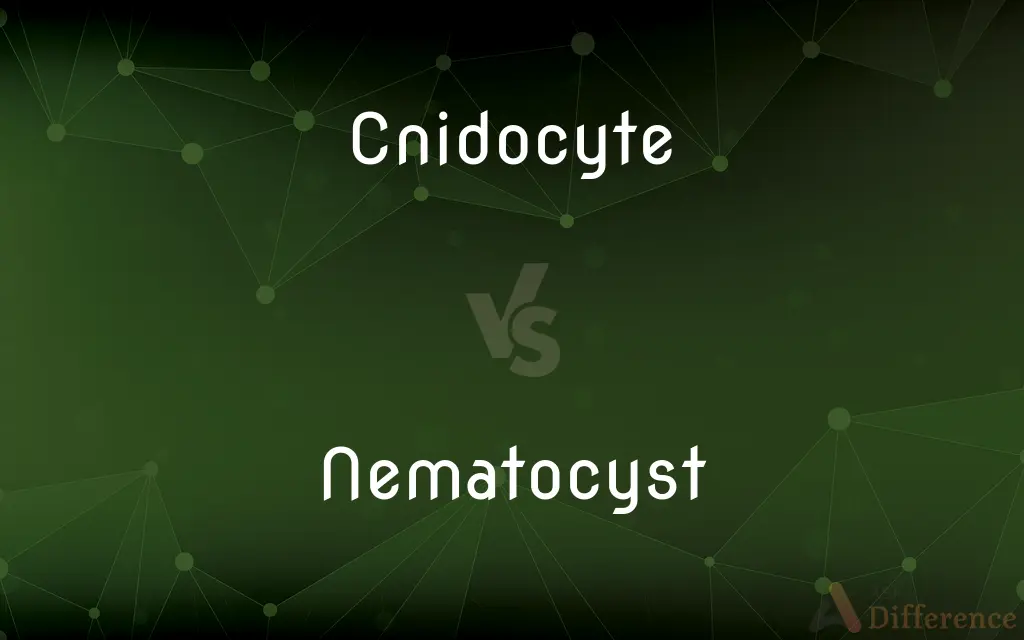Cnidocyte vs. Nematocyst — What's the Difference?
By Tayyaba Rehman — Published on October 5, 2023
Cnidocyte is a specialized cell in certain aquatic animals that contains an organelle used for stinging, while a nematocyst is the stinging organelle within the cnidocyte.

Difference Between Cnidocyte and Nematocyst
Table of Contents
ADVERTISEMENT
Key Differences
Cnidocytes and nematocysts are crucial components in cnidarians, like jellyfish, anemones, and corals. A cnidocyte is a unique type of cell found in these animals, equipped with the capability to release venom. Nematocysts, on the other hand, are specialized intracellular organelles housed within the cnidocyte and responsible for delivering the sting.
Both cnidocytes and nematocysts play essential roles in the survival of cnidarians. The cnidocyte provides the mechanism for the animal to capture its prey or defend against potential threats. Within the cnidocyte, the nematocyst is coiled and under tension, ready to be deployed when the cnidocyte is triggered.
It's important to clarify the relationship between these two entities. While every nematocyst resides inside a cnidocyte, not every part of a cnidocyte is a nematocyst. Think of the cnidocyte as the "gun" and the nematocyst as the "bullet." The cnidocyte is the cell that houses and deploys the nematocyst.
In many cases, the sting from the nematocyst's release can be painful or harmful to humans. For instance, when someone says they were stung by a jellyfish, it's the nematocysts from the cnidocytes in the jellyfish's tentacles that are responsible for the sting.
Comparison Chart
Nature
A specialized cell.
An organelle inside the cnidocyte.
ADVERTISEMENT
Function
Houses and deploys the nematocyst.
Delivers the sting or venom.
Location
Found in the epidermis of cnidarians.
Located inside the cnidocyte.
Relation
General term for the cell with stinging capability.
Specific term for the stinging organelle itself.
Interaction with Prey
Responds to chemical or physical stimuli.
Directly responsible for stinging the prey.
Compare with Definitions
Cnidocyte
Cnidocytes are specialized cells in cnidarians equipped for stinging.
The jellyfish's tentacles contain thousands of cnidocytes ready to deploy.
Nematocyst
They are coiled and under tension, ready to fire when triggered.
The nematocyst shoots out rapidly upon stimulation.
Cnidocyte
These cells play a vital role in defense and capturing prey for cnidarians.
The cnidocyte's stinging capability helps protect the coral from threats.
Nematocyst
A nematocyst is a venomous organelle housed within the cnidocyte.
The sting from the jellyfish is directly from the nematocyst's release.
Cnidocyte
They contain the venomous organelle, nematocyst, which delivers the sting.
When the cnidocyte is triggered, it releases the nematocyst.
Nematocyst
Each nematocyst has a tiny, coiled, barbed thread that delivers venom.
When the nematocyst is deployed, its thread pierces and releases venom into the prey.
Cnidocyte
Found primarily in the epidermis of cnidarians, cnidocytes are crucial for survival.
Without cnidocytes, many cnidarians would struggle to feed or defend themselves.
Nematocyst
Nematocysts are responsible for the sting in cnidarians like jellyfish.
Swimmers should be cautious of nematocysts in certain jellyfish species.
Cnidocyte
Cnidocytes respond to chemical or physical stimuli from the environment.
A small fish brushing against the cnidocyte can trigger its response.
Nematocyst
They play a crucial role in defense and prey capture for cnidarians.
The nematocyst's venom can immobilize small prey instantly.
Cnidocyte
A cnidocyte (also known as a cnidoblast or nematocyte) is an explosive cell containing one giant secretory organelle called a cnidocyst (also known as a cnida (plural cnidae) or nematocyst) that can deliver a sting to other organisms. The presence of this cell defines the phylum Cnidaria (corals, sea anemones, hydrae, jellyfish, etc.).
Nematocyst
A capsule within specialized cells in the tentacles of cnidarians, such as jellyfish and corals, containing a barbed, threadlike tube that delivers a toxic sting to predators and prey.
Cnidocyte
(biology) A capsule, in certain cnidarians, containing a barbed, string-like tube that transfers a paralyzing sting. Synonyms: nematocyst,cnidoblast
Nematocyst
(biology) A capsule, in certain cnidarians, containing a barbed, threadlike tube that delivers a paralyzing sting
Cnidocyte
(biology) A jellyfish tentacle. Synonyms: lappet
Nematocyst
A lasso cell, or thread cell. See Lasso cell, under Lasso.
Common Curiosities
What is a cnidocyte?
A cnidocyte is a specialized cell in cnidarians equipped for stinging.
Where are cnidocytes commonly found?
Cnidocytes are found in cnidarians like jellyfish, anemones, and corals.
Can the sting from a nematocyst harm humans?
Yes, some nematocysts, especially in certain jellyfish, can be painful or even dangerous to humans.
How fast does a nematocyst deploy?
Nematocysts deploy extremely quickly, often in just a few milliseconds.
How does a nematocyst differ from a cnidocyte?
A nematocyst is the venomous organelle inside the cnidocyte responsible for the sting.
Are cnidocytes visible to the naked eye?
While cnidocytes themselves might be hard to discern, the effects, like a jellyfish's sting, are very noticeable.
What's the evolutionary advantage of having cnidocytes?
Cnidocytes provide cnidarians with a means of defense and an efficient way to capture prey.
What's the primary function of cnidocytes in cnidarians?
Cnidocytes play a dual role in defense against threats and capturing prey.
Do all nematocysts contain venom?
Most nematocysts contain venom, but the potency and type can vary among species.
Is the nematocyst the same as the venom?
No, the nematocyst is the organelle that delivers the venom, which is a substance it contains.
What triggers a nematocyst to fire?
Nematocysts can be triggered by chemical or physical stimuli from the environment.
Do all cnidarians have cnidocytes?
Most cnidarians have cnidocytes, but the type and potency of the nematocyst can vary.
Can a nematocyst fire multiple times?
Typically, a nematocyst can fire only once and then becomes spent.
How do cnidarians replenish used nematocysts?
Cnidarians continually produce new cnidocytes to replace those that have fired their nematocysts.
Can humans develop an allergic reaction to nematocyst stings?
Yes, some individuals might have allergic reactions to stings, leading to more severe symptoms.
Share Your Discovery

Previous Comparison
Smartphone vs. Feature Phone
Next Comparison
EST vs. EDTAuthor Spotlight
Written by
Tayyaba RehmanTayyaba Rehman is a distinguished writer, currently serving as a primary contributor to askdifference.com. As a researcher in semantics and etymology, Tayyaba's passion for the complexity of languages and their distinctions has found a perfect home on the platform. Tayyaba delves into the intricacies of language, distinguishing between commonly confused words and phrases, thereby providing clarity for readers worldwide.
















































